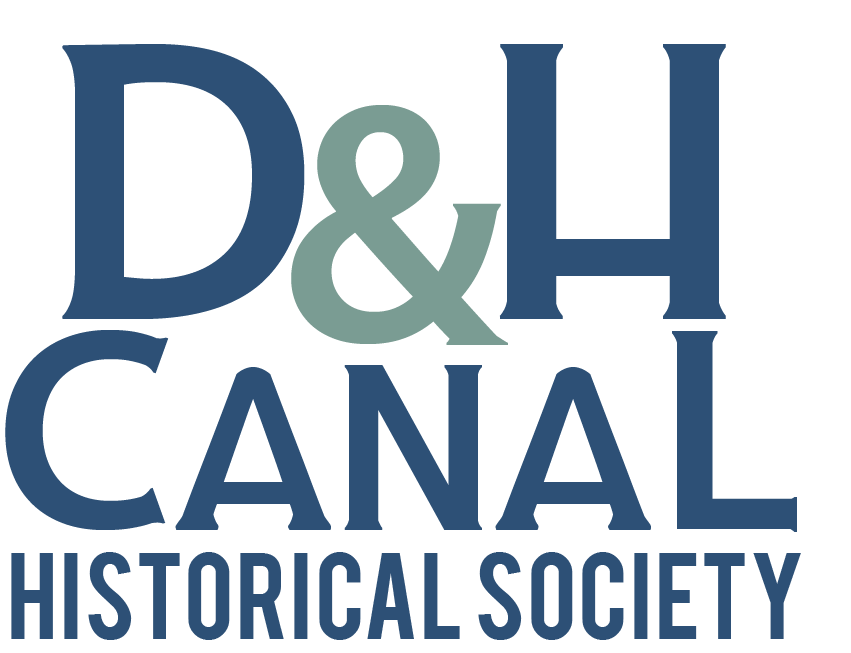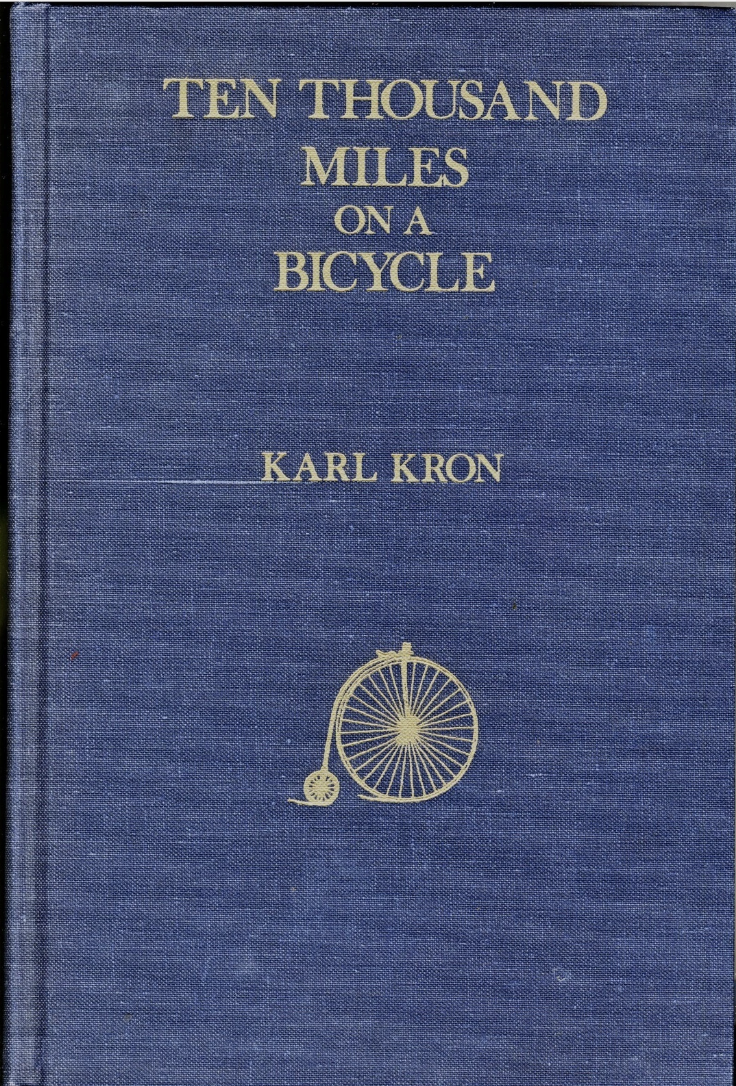Ten Thousand Miles on a Bicycle
An excerpt from Karl Kron’s book Ten Thousand Miles retelling a near-calamitous conflict between the author’s high wheel bicycle and a mule team on the towpath of the Delaware & Hudson Canal.
The towpath of the Delaware and Hudson Canal, a few miles from Honesdale, was the scene of the worst mishap that ever befell “Number 234,” and its escape from complete destruction then will always seem to me like a miracle. A pair of mules, standing on the outer side of the path, appeared to have their attention so entirely absorbed by the feed-baskets wherein their noses were plunged, that I presumed they would not notice my approach from behind, and I accordingly ventured to ride across the tug-rope connecting them with the boat. No sooner had I done this than some evil impulse led the brutes to pause in their repast and take a contemplative gaze at the surrounding scenery. I dismounted at the moment when I saw them turn their heads ; but, in the self-same instant of time, they gave a tremendous jump forward; the rope parted under the sudden strain, the flying end thereof, glancing from my back, whipped itself into a knot around the right handle of my bicycle, and, quicker than I could say "Jack Robinson," the beloved form of “Number 234” was receding into the distance, as fast as a pair of runaway mules could bang it along the stones of the tow-path. They were excited enough to have willingly helped it " beat the record " by dragging it " without stop for a hundred miles," or until they reached the Hudson River; but a lock-house chanced to intervene at the distance of an eighth of a mile, and the keeper thereof rushed out and brought their mad race to an end. Just about as he seized hold of them, the front wheel came a gainst the planking of a bridge with a tremendous thump; but I was so far in the rear that I could not see whether this helped to cause the stoppage; and I was so excited and distressed, when I rushed up to view the mangled remains of the wreck, that I cannot remember whether the jar of the collision sufficed to release the knotted rope from the handle. I only recall that the machine was lying quietly there on the bridge, and that the lock-tender, a few rods beyond, was driving away the morning mist by the warmth of his cursings at the mules.
“I am older than some sorrows," — for no traveler on Life's highway ever gets past its half-way stone, which marks the beginning of the down-grade leading towards the place called Seventy, without having experiences that cause him to grieve ; — but I cannot recollect another moment of my existence when I felt so thoroughly, intensely, desperately " sick," as that moment on the tow-path, out in the wilds of Pennsylvania, when “Number 234” was whisked out of my hands, like an object in the " transformation scene " of a, pantomime. With its destruction, which seemed inevitable, many of my cherished hopes and plans would fall in a common ruin. I should never again be likely to have a continuous trail extending for 900 miles behind me, and, simultaneously, a fairly good road of 500 miles stretching straightaway before me. I could never again reasonably expect to " beat the record " of coned-bearing machines, or to win the right of putting together a book called “Ten Thousand Miles on a Bicycle”! The thought of my own reckless folly, in bringing about the disaster, filled my soul with bitterness, as I hurried dolefully along after the runaways. Other greater afflictions I had endured cheerfully as inexorable decrees of Fate, for which I was not responsible; but here was a calamity which I had definitely and deservedly brought upon myself. So absorbing was my exasperation on this score that the thought of my own personal peril in the case did not occur to me till later in the day. The driver of the boat appreciated it, however, and his pleasure at seeing me escape with my life was great enough to prevent his getting angry with me for the trouble which my mishap caused him. Had not his tow-line been an old and weak one, which gave way at the first jerk, I myself should necessarily have been pitched into the canal, and if the bicycle had been thrown in on top of me, or if I had come into contact with the boat while under water, I should probably have been killed. On the other hand, if the flying end of the severed rope had chanced to bind my arm to the bicycle, instead of simply knotting around the handle, I should have had my own broken bones to bewail, instead of “Number 234's”, as the mules careered along.
And now I come to the miracle in the case, for not a single part of the machine was really broken! Though bent and cracked and scratched and badly demoralized in its several parts, my beloved bicycle had survived this crucial test, — had maintained its integrity as a whole, and was still ridable! The handle-bar was doubled back, and, when I bent it into its place again, it cracked where the splice had recently been made, and soon broke off entirely. I therefore steered with a wagon-spoke for the next eight miles, until I reached a blacksmith shop where I could get the bar rewelded. The crank and pedal-pin on the right side were considerably bent, and the axle was deflected from a true line, while the rim was bent and cracked at the point where it struck the bridge, and two or three of the adjacent spokes were thereby loosened and made useless. One of them broke off a few days later, and I gave it for a keepsake to a rider in Carlisle. The iron plate of the long-distance saddle — with which I began the season of '83, and which served me satisfactorily to the last — was cracked in two places, so that it never afterwards coul d be screwed with perfect firmness to the spring. One end of the wire of my Lamson luggage-carrier was also twisted off, but the carrier, like the saddle, I nevertheless kept in service until the very last day of the record. That my heavy roll of luggage was not shaken apart and scattered along the path, seemed by no means the least remarkable incident of the runaway. At Port Jervis, on the day following, I met the new handle-bar, which I ordered at the time of the first breakage in Canada, and it stood by me to the end, without further accident. The old bar I gave to a local wheelman who befriended me, and who said he would religiously preserve it as a relic of the first American tour of a thousand miles straightaway," — for I completed that distance at four o'clock in the afternoon of the day when the old bar (whose entire record was 6,798 miles) served for the last time as my tiller. The town of Staunton, in Virginia, where my monumental ride was completed, on the 22d of November, marks the end of the macadamized roadway which stretches through the Shenandoah Valley, and is continuously ridable from Greencastle, the border town of Pennsylvania, a distance of 150 miles. As a muddy clay of indescribable tenacity was prohibitory of progress beyond Staunton, I abandoned all idea of pushing on to the Natural Bridge, and decided to wheel back down the valley, and so home to New York. But the bulge in the rim, resulting from the accident with the mules, was sufficiently pronounced to give me a definite jolt at each revolution of the wheel during the 463 miles subsequently traversed in reaching the goal; and I thought that, before beginning the return journey, I might perhaps remedy the matter a little by " tightening up the spokes." It was my first experience of the sort, and it proved quite effectual, — though not in the manner intended. When I had completed the tightening process, I found the rim was so badly twisted that it would not revolve in the fork at all ; and my later efforts to " unbuckle " it were quite in vain, though I snapped another spoke in making them.
“Number 234” was thus at last entirely disabled, — having survived the attack of the mules only to fall a victim to my own mechanical awkwardness. A man from a carriage shop, who was recommended to me as the most skillful mechanic in town, said he would not even undertake the task of straightening the wheel for less than five dollars, and that he would not agree to finish the task for any possible sum. I knew indeed that no one outside of Hartford would have the patience to really put it to rights again, and I am told that the expert machinist who there did in fact take it in charge had a sad and solemn time in bringing it once more into ridable shape. I drove it from Hartford to New York in the early part of December, and, at the close of the month, rode a hundred miles, on the snow and ice, in the region around Springfield, without having a fall. I expected then to do no more touring with it, but to run off the few remaining miles needed for a " record " in short spins of an hour or two at a time; yet when next I set eyes on the wheel, on the 6th of March, it was in the hold of a steamer starting on a 700-mile voyage for Bermuda. Before I had been there twenty-four hours, the sudden turning of a team in front of me forced me to make a quick backward dismount, and then fall forward with my full weight on the fallen machine. The result of this was such a severe bend or crack in the right end of the axle that a compensating bend had to be made in the crank before the wheel would revolve.
Pages 44-48
Found and shared by Nancy Banchana, Education Director

